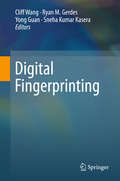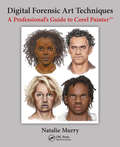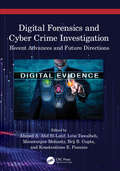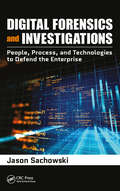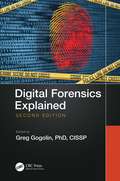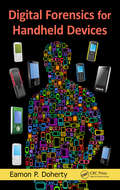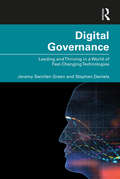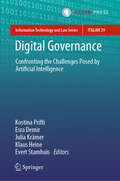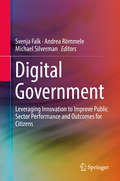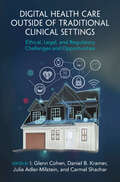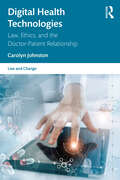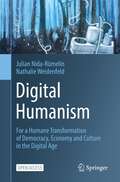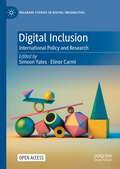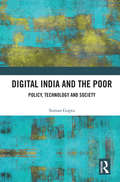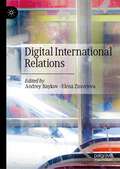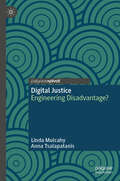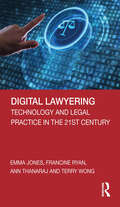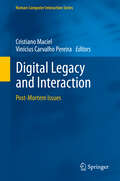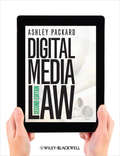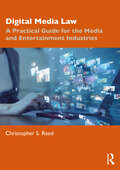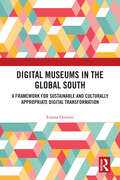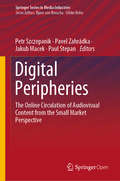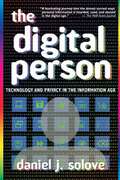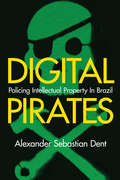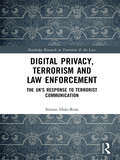- Table View
- List View
Digital Fingerprinting
by Cliff Wang Ryan M. Gerdes Yong Guan Sneha Kumar KaseraThis is the first book on digital fingerprinting that comprehensively covers the major areas of study in a range of information security areas including authentication schemes, intrusion detection, forensic analysis and more. Available techniques for assurance are limited and authentication schemes are potentially vulnerable to the theft of digital tokens or secrets. Intrusion detection can be thwarted by spoofing or impersonating devices, and forensic analysis is incapable of demonstrably tying a particular device to specific digital evidence. This book presents an innovative and effective approach that addresses these concerns. This book introduces the origins and scientific underpinnings of digital fingerprinting. It also proposes a unified framework for digital fingerprinting, evaluates methodologies and includes examples and case studies. The last chapter of this book covers the future directions of digital fingerprinting. This book is designed for practitioners and researchers working in the security field and military. Advanced-level students focused on computer science and engineering will find this book beneficial as secondary textbook or reference.
Digital Forensic Art Techniques: A Professional’s Guide to Corel Painter
by Natalie MurryDigital Forensic Art Techniques: A Professional’s Guide to Corel PainterTM illustrates hands-on techniques to digitally create forensic art for police and investigative purposes. Coverage focuses specifically on how to utilize the software to create realistic human likenesses, including composites of suspects and drawings of persons in unidentified remains cases. Drawing digitally is like using any tool in art: a pencil, a charcoal stick, a conte’ crayon. A stylus is just another tool to master. Digital work is easier for artists to send to the case detective, and the work always reproduces exactly as it was completed. Another benefit to working digitally is that one can use video conferencing with a witness online to provide services remotely world-wide. This enables police departments who have never had access to a forensic artist to have a sketch done within hours of the crime. Chapters address the more basic functions to serve as a primer for those transitioning to working digitally. There is also instruction on light and shadow, and bones and muscles of the skull. All of the discussion is intended to make the reader see things as an artist to improve drawing skills and overall digital techniques. In short, Digital Forensic Art Techniques is a practical, easy-to-follow manual for working forensic artists that will give readers a solid base from which to start. It serves as an essential resource to greater skill and comfort with the hardware and software, thus furthering current best practices and technological advances in the field.
Digital Forensics and Cyber Crime Investigation: Recent Advances and Future Directions
by Ahmed A. Abd El-Latif Lo’ai Tawalbeh Manoranjan Mohanty Brij B. Gupta Konstantinos E. PsannisIn the ever-evolving landscape of digital forensics and cybercrime investigation, staying ahead with the latest advancements is not just advantageous—it’s imperative. Digital Forensics and Cyber Crime Investigation: Recent Advances and Future Directions serves as a crucial bridge, connecting the dots between the present knowledge base and the fast-paced developments in this dynamic field. Through a collection of meticulous research and expert insights, this book dissects various facets of digital forensics and cyber security, providing readers with a comprehensive look at current trends and future possibilities. Distinguished by its in-depth analysis and forward-looking perspective, this volume sets itself apart as an indispensable resource for those keen on navigating the complexities of securing the digital domain. Key features of this book include: Innovative Strategies for Web Application Security: Insights into Moving Target Defense (MTD) techniques Blockchain Applications in Smart Cities: An examination of how blockchain technology can fortify data security and trust Latest Developments in Digital Forensics: A thorough overview of cutting-edge techniques and methodologies Advancements in Intrusion Detection: The role of Convolutional Neural Networks (CNN) in enhancing network security Augmented Reality in Crime Scene Investigations: How AR technology is transforming forensic science Emerging Techniques for Data Protection: From chaotic watermarking in multimedia to deep learning models for forgery detection This book aims to serve as a beacon for practitioners, researchers, and students who are navigating the intricate world of digital forensics and cyber security. By offering a blend of recent advancements and speculative future directions, it not only enriches the reader’s understanding of the subject matter but also inspires innovative thinking and applications in the field. Whether you’re a seasoned investigator, an academic, or a technology enthusiast, Digital Forensics and Cyber Crime Investigation: Recent Advances and Future Directions promises to be a valuable addition to your collection, pushing the boundaries of what’s possible in digital forensics and beyond.
Digital Forensics and Investigations: People, Process, and Technologies to Defend the Enterprise
by Jason SachowskiDigital forensics has been a discipline of Information Security for decades now. Its principles, methodologies, and techniques have remained consistent despite the evolution of technology, and, ultimately, it and can be applied to any form of digital data. However, within a corporate environment, digital forensic professionals are particularly challenged. They must maintain the legal admissibility and forensic viability of digital evidence in support of a broad range of different business functions that include incident response, electronic discovery (ediscovery), and ensuring the controls and accountability of such information across networks. Digital Forensics and Investigations: People, Process, and Technologies to Defend the Enterprise provides the methodologies and strategies necessary for these key business functions to seamlessly integrate digital forensic capabilities to guarantee the admissibility and integrity of digital evidence. In many books, the focus on digital evidence is primarily in the technical, software, and investigative elements, of which there are numerous publications. What tends to get overlooked are the people and process elements within the organization. Taking a step back, the book outlines the importance of integrating and accounting for the people, process, and technology components of digital forensics. In essence, to establish a holistic paradigm—and best-practice procedure and policy approach—to defending the enterprise. This book serves as a roadmap for professionals to successfully integrate an organization’s people, process, and technology with other key business functions in an enterprise’s digital forensic capabilities.
Digital Forensics Explained
by Greg GogolinThis book covers the full life cycle of conducting a mobile and computer digital forensic examination, including planning and performing an investigation as well as report writing and testifying. Case reviews in corporate, civil, and criminal situations are also described from both prosecution and defense perspectives. Digital Forensics Explained, Second Edition draws from years of experience in local, state, federal, and international environments and highlights the challenges inherent in deficient cyber security practices. Topics include the importance of following the scientific method and verification, legal and ethical issues, planning an investigation (including tools and techniques), incident response, case project management and authorization, social media and internet, cloud, anti-forensics, link and visual analysis, and psychological considerations. The book is a valuable resource for the academic environment, law enforcement, those in the legal profession, and those working in the cyber security field. Case reviews include cyber security breaches, anti-forensic challenges, child exploitation, and social media investigations. Greg Gogolin, PhD, CISSP, is a Professor of Information Security and Intelligence at Ferris State University and a licensed Professional Investigator. He has worked more than 100 cases in criminal, civil, and corporate environments.
Digital Forensics for Handheld Devices
by Eamon P. DohertyApproximately 80 percent of the worlds population now owns a cell phone, which can hold evidence or contain logs about communications concerning a crime. Cameras, PDAs, and GPS devices can also contain information related to corporate policy infractions and crimes. Aimed to prepare investigators in the public and private sectors, Digital Forensics
Digital Governance: Leading and Thriving in a World of Fast-Changing Technologies
by Jeremy Swinfen Green Stephen DanielsDigital Governance provides managers with a simple and jargon-free introduction to the impact that digital technology can have on the governance of their organisations. Digital technology is at the heart of any enterprise today, changing business processes and the way we work. But this technology is often used inefficiently, riskily or inappropriately. Worse perhaps, many organisational leaders fail to grasp the opportunities it offers and thus fail to "transform" their organisations through the use of technology. This book provides an explanation of the basic issues around the opportunities and risks associated with digital technology. It describes the role that digital technology can play across organisations (and not just behind the locked doors of the IT department), giving boards and top management the insight to develop strategies for investing in and exploiting digital technology as well as arming them with the knowledge required to ask the right questions of specialists and to detect when the answers given are evasive or irrelevant. International in its scope, this essential book covers the fundamental principles of digital governance such as leadership, capability, accountability for value creation and transparency of reporting, integrity and ethical behaviour.
Digital Governance: Confronting the Challenges Posed by Artificial Intelligence (Information Technology and Law Series #39)
by Kostina Prifti Esra Demir Julia Krämer Klaus Heine Evert StamhuisThis book explores the structure and frameworks of digital governance, focusing on various regulatory patterns, with the aim of tackling the disruptive impact of artificial intelligence (AI) technologies. Addressing the various challenges posed by AI technologies, this book explores potential avenues for crafting legal remedies and solutions, spanning liability of AI, platform governance, and the implications for data protection and privacy. The book is valuable for audiences with or without a technological background. Primarily, it targets academic scholars from a variety of disciplines, including law, ethics, sociology, political science, economics, computer science, and engineering. Particularly, academics interested in interdisciplinary and transdisciplinary studies would benefit from the mixture of disciplines in the book. The scholarly insights in this work are valuable also for policymakers and civil society, by providing potential guidance for effective AI regulation. Additionally, the book can be useful to private companies and organisations that are involved in designing AI applications, offering practical insights and guidance about the legal and societal implications of AI. Kostina Prifti, Esra Demir and Julia Krämer are PhD candidates at Erasmus School of Law, Rotterdam, the Netherlands. Klaus Heine is Professor of Law and Economics at Erasmus School of Law, Rotterdam, the Netherlands. Evert Stamhuis is Professor of Law and Innovation at Erasmus School of Law, Rotterdam, the Netherlands. Chapter 2, Chapter 6, Chapter 10, and Chapter 13 are available open access under a via link.springer.com.
Digital Government: Leveraging Innovation to Improve Public Sector Performance and Outcomes for Citizens
by Svenja Falk, Andrea Römmele and Michael SilvermanThis book focuses on the implementation of digital strategies in the public sectors in the US, Mexico, Brazil, India and Germany. The case studies presented examine different digital projects by looking at their impact as well as their alignment with their national governments’ digital strategies. The contributors assess the current state of digital government, analyze the contribution of digital technologies in achieving outcomes for citizens, discuss ways to measure digitalization and address the question of how governments oversee the legal and regulatory obligations of information technology. The book argues that most countries formulate good strategies for digital government, but do not effectively prescribe and implement corresponding policies and programs. Showing specific programs that deliver results can help policy makers, knowledge specialists and public-sector researchers to develop best practices for future national strategies.
Digital Health Care outside of Traditional Clinical Settings: Ethical, Legal, and Regulatory Challenges and Opportunities
by I. Glenn Cohen Daniel B. Kramer Julia Adler-Milstein Carmel ShacharHealth care delivery is shifting away from the clinic and into the home. Even prior to the COVID-19 pandemic, the use of telehealth, wearable sensors, ambient surveillance, and other products was on the rise. In the coming years, patients will increasingly interact with digital products at every stage of their care, such as using wearable sensors to monitor changes in temperature or blood pressure, conducting self-directed testing before virtually meeting with a physician for a diagnosis, and using smart pills to document their adherence to prescribed treatments. This volume reflects on the explosion of at-home digital health care and explores the ethical, legal, regulatory, and reimbursement impacts of this shift away from the 20th-century focus on clinics and hospitals towards a more modern health care model. This title is also available as Open Access on Cambridge Core.
Digital Health Technologies: Law, Ethics, and the Doctor-Patient Relationship (Law and Change)
by Carolyn JohnstonIncreasingly digital technologies are used in healthcare. This book explores eight digital health technologies, situated the context of a life span, from high-throughput genomic sequencing technologies and do-it-yourself (DIY) insulin delivery for diabetes management in paediatrics, to the use of robotic care assistants for older adults and digital advance care decisions. A scene-setting case scenario at the start of each chapter describes the digital technology and identifies the sometimes competing interests of the key stakeholders. Broad themes of resource allocation, access to technologies, informed consent, privacy of health data and ethical concerns are considered in context, alongside analysis of legal duties owed by healthcare professionals to act in their patients’ best interests. This book addresses legal and ethical issues arising from the use of emerging digital health technologies and is of interest to academics, clinicians and regulators and anyone interested in the development of health technologies and the challenges they may present. It focusses on the Australian legal framework, with some comparison to other jurisdictions.
Digital Humanism: For a Humane Transformation of Democracy, Economy and Culture in the Digital Age
by Julian Nida-Rümelin Nathalie WeidenfeldThis open access book deals with cultural and philosophical aspects of artificial intelligence (AI) and pleads for a “digital humanism”. This term is beginning to be en vogue everywhere. Due to a growing discontentment with the way digitalization is being used in the world, particularly formulated by former heroes of Internet, social media and search engine companies, philosophical as well as industrial thought leaders begin to plead for a humane use of digital tools. Yet the term “digital humanism” is a particular terminology that lacks a sound conceptual and philosophical basis and needs clarification still – and this gap is exactly filled by this book. It propagates a vision of society in which digitization is used to strengthen human self-determination, autonomy and dignity and whose time has come to be propagated throughout the world. The advantage of this book is that it is philosophically sound and yet written in a way that will make it accessible for everybody interested in the subject. Every chapters begins with a film scene illustrating a precise philosophical problem with AI and how we look at it – making the book not only readable, but even entertaining. And after having read the book the reader will have a clear vision of what it means to live in a world where digitization and AI are central technologies for a better and more humane civilization.
Digital Inclusion: International Policy and Research (Palgrave Studies in Digital Inequalities)
by Simeon Yates Elinor CarmiThis collection presents policy and research that addresses digital inequalities, access, and skills, from multiple international perspectives. With a special focus on the impact of the COVID-19, the collection is based on the 2021 Digital Inclusion, Policy and Research Conference, with chapters from both academia and civic organizations.The COVID-19 pandemic has changed citizens’ relationship with digital technologies for the foreseeable future. Many people’s main channels of communication were transferred to digital services, platforms, and apps. Everything ‘went online’: our families, friends, partners, health, work, news, politics, culture, arts and protesting. Yet access to digital technologies remained highly unequal. This brought digital inclusion policy and research to the fore, highlighting to policymakers and the public the ‘hidden’ challenges and impacts of digital exclusion and inequalities. The cutting-edge volume offers research findings and policycase studies that explore digital inclusion from the provision of basic access to digital, via education and digital literacy, and on to issues of gender and technology. Case studies are drawn from varied sources including the UK, Australia, South America, and Eastern Europe, providing a valuable resource in the pursuit of social equity and justice.This is an open access book.
Digital India and the Poor: Policy, Technology and Society
by Suman GuptaDigital India and The Poor examines how the poor are evoked in contemporary Indian political discourse. It studies the ways in which the disadvantaged are accounted for in the increasingly digitised political economy, commercial and public policy, media, and academic research. This book: Interrogates the category of the poor in India and how they have come to be classified in economic and policy documents over the past few decades Explores the influential digital education technology ‘experiments’ conducted in Indian slums from the late 1990s, now popularly known as the ‘hole-in-the-wall experiments’ Discusses financial inclusion initiatives, predominantly as they converged between 2014 and 2017, such as the Jan Dhan Yojana, the Aadhaar Project, and the banknote demonetisation Presents an in-depth study of the bearing of technology on domestic employment in India The book will be of great interest to scholars and researchers of South Asian studies, politics, political science and sociology, technology studies, linguistics, and development studies.
Digital International Relations
by Andrey Baykov Elena ZinovievaThe book is the beginning of new interdisciplinary research series at the intersection of international relations, diplomacy, law, economics, and politics on the basis of global digital transformation. Digital international relations form a new mode of interaction between states and in terms of solving the most pressing problems of modernity. Law, economics, diplomacy and education are selected as key areas of human activity that can become the sphere of perspective research of digital international relations. This book will interest diplomats, scholars of international relations, and of international law.
Digital Justice: Engineering Disadvantage? (Palgrave Socio-Legal Studies)
by Linda Mulcahy Anna TsalapatanisThis book explores an increasingly important issue for legal systems across the world. It asks what do we lose and gain when legal proceedings go online? Adopting a multi-disciplinary socio-legal perspective, it draws on an emerging body of empirical evidence from the UK, Australia, Canada and the US about the ways in which digital justice is being conceived of and experienced. Insights are drawn from across the social sciences to discuss the interface of digitalisation with a range of issues such as due process, procedural justice, digital disadvantage, ceremony and ritual, science and technology studies and the dematerialisation of the civic sphere. Written accessibly and provocatively, it poses questions from a variety of different perspective with a particular focus on marginalised groups.
Digital Lawyering: Technology and Legal Practice in the 21st Century
by Emma Jones Francine Ryan Ann Thanaraj Terry WongIn today’s rapidly changing legal landscape, becoming a digital lawyer is vital to success within the legal profession. This textbook provides an accessible and thorough introduction to digital lawyering, present and future, and a toolkit for gaining the key attributes and skills required to utilise technology within legal practice effectively. Digital technologies have already begun a radical transformation of the legal profession and the justice system. Digital Lawyering introduces students to all key topics, from the role of blockchain to the use of digital evidence in courtrooms, supported by contemporary case studies and integrated, interactive activities. The book considers specific forms of technology, such as Big Data, analytics and artificial intelligence, but also broader issues including regulation, privacy and ethics. It encourages students to explore the impact of digital lawyering upon professional identity, and to consider the emerging skills and competencies employers now require. Using this textbook will allow students to identify, discuss and reflect on emerging issues and trends within digital lawyering in a critical and informed manner, drawing on both its theoretical basis and accounts of its use in legal practice. Digital Lawyering is ideal for use as a main textbook on modules focused on technology and law, and as a supplementary textbook on modules covering lawyering and legal skills more generally.
Digital Legacy and Interaction
by Cristiano Maciel Vinícius Carvalho PereiraThe views of leading researchers on the emerging topic of post-mortem digital legacy and posthumous interaction are explored in this book which combines the technical, cultural and legal aspects associated with this new branch of HCI. The technical aspects of emerging technologies, both for the web and mobile platforms, are analysed and useful information is provided for system development, requirements engineering, and data management and storage. The authors address the cultural aspects of virtual identity, ethical problems, cross-culture differences regarding memories and death, bereavement, taboos and beliefs, and the visual/verbal representations of death. The legal aspects covered include regulation, property, privacy and conflicts between international and local jurisdictions. The coverage of Digital Legacy and Interaction: Post-Mortem Issues is relevant to the development of systems that consider the influence of death, bereavement and mortality on Human Computer Interaction. The interdisciplinary approach that guides this book is intended to foster enriching and innovative discussions amongst HCI scholars and professionals. Cristiano Maciel and Vinícius Carvalho Pereira are researchers at LAVI (Laboratory of Interactive Virtual Environments) and professors at UFMT (Federal University of Mato Grosso, Brazil).
Digital Media Law
by Ashley PackardCovering the latest legal updates and rulings, the second edition of Digital Media Law presents a comprehensive introduction to all the critical issues surrounding media law. Provides a solid foundation in media lawIllustrates how digitization and globalization are constantly shifting the legal landscapeUtilizes current and relevant examples to illustrate key conceptsRevised section on legal research covers how and where to find the lawUpdated with new rulings relating to corporate political speech, student speech, indecency and Net neutrality, restrictions on libel tourism, cases filed against U.S. information providers, WikiLeaks and shield laws, file sharing, privacy issues, sexting, cyber-stalking, and many othersAn accompanying website is regularly updated with new rulings, access to slip opinions and other supplementary material.
Digital Media Law: A Practical Guide for the Media and Entertainment Industries
by Christopher S. ReedDigital Media Law offers a practical guide to the law of media and communication, focusing on digital channels, models, and technologies. It draws together the aspects of media law that are most critical for those engaged in the production and distribution of digital media, from traditional broadcasters and internet-based services to major internet platforms. As an expert scholar and educator in media law, Christopher S. Reed brings considerable experience as an in-house lawyer for a U.S.-based media company with extensive news, sports, and entertainment operations. This blend of practical and scholarly insight delivers a textbook which packs foundational principles and concepts into the context of the digital environment, focusing on how those doctrines are applied in the face of rapidly evolving newsgathering, production, and distribution technologies. Key features include: "In the News" sections that tie the legal principles to real-world events or situations An integrated fictional case study of a media enterprise Insights into digital media policy. This accessible textbook is the ideal companion for advanced undergraduate and graduate students as well as practitioners interested in law, journalism, and media studies.
Digital Museums in the Global South: A Framework for Sustainable and Culturally Appropriate Digital Transformation
by Emma DuesterThis book focuses on digital museums in the context of Vietnam and contributes to global discussions on the development of digital museum offerings needed to meet audience demands, requirements for sustainable digitisation methods for cultural heritage, demands for the development of intellectual property protection for the digital environment, and shows ways for national governments to support digital museums.Duester provides insight into museums in part of the Global South, where infrastructure funding and technical and human resource constraints impact the take-up and display of digital content. With on-the-ground research from three Vietnamese museums, Duester argues for a museum framework that is sustainable, ethical, and culturally appropriate. The Vietnamese government’s strategy for digitalisation of culture, heritage, and museums is assessed, and the book includes a list of recommendations on sustainable digitisation methods, intellectual property protection measures for the digital environment, management, phygital business models, and new digital revenue streams.The volume will benefit scholars involved in the cultural and creative industries, as well as museum professionals and cultural policymakers who will value the book’s assessment of international standards, treaties, and conventions on copyright law and how they apply to museums, as well as the recommendations listed above.
Digital Peripheries: The Online Circulation of Audiovisual Content from the Small Market Perspective (Springer Series in Media Industries)
by Petr Szczepanik Pavel Zahrádka Jakub Macek Paul StepanThis is an open access book. Media industry research and EU policymaking are predominantly tailored to large (and, in the latter case, Western) European markets. This open access book addresses the specific qualities of smaller media markets, highlighting their vulnerability to global digital competition and outlining survival strategies for them. New online distribution models and new trends in the consumption of audiovisual content are limited by, and pose new challenges for, existing audiovisual business models and their legal framework in the EU. The European Commission’s Digital Single Market (DSM) strategy, which was intended e.g. to remove obstacles to the cross-border distribution of audiovisual content, has triggered a heated debate on the transformation of the existing ecosystem for European screen industries. While most current discussions focus on the United States, Western Europe, and the multinational giants, this book approaches these industry trends and policy questions from the perspective of relatively small and peripheral (in terms of their population, language, cross-border cultural flows, and financial and/or symbolic capital) media markets.
The Digital Person: Technology and Privacy in the Information Age (Ex Machina: Law, Technology, and Society #1)
by Daniel J SoloveA startling account of personal data dossiers and the newest grave threat to privacySeven days a week, twenty-four hours a day, electronic databases are compiling information about you. As you surf the Internet, an unprecedented amount of your personal information is being recorded and preserved forever in the digital minds of computers. For each individual, these databases create a profile of activities, interests, and preferences used to investigate backgrounds, check credit, market products, and make a wide variety of decisions affecting our lives. The creation and use of these databases—which Daniel J. Solove calls “digital dossiers”—has thus far gone largely unchecked. In this startling account of new technologies for gathering and using personal data, Solove explains why digital dossiers pose a grave threat to our privacy.The Digital Person sets forth a new understanding of what privacy is, one that is appropriate for the new challenges of the Information Age. Solove recommends how the law can be reformed to simultaneously protect our privacy and allow us to enjoy the benefits of our increasingly digital world.This is the first volume in the series EX MACHINA: LAW, TECHNOLOGY, AND SOCIETY.
Digital Pirates: Policing Intellectual Property in Brazil
by Alexander Sebastian DentDigital Pirates examines the unauthorized creation, distribution, and consumption of movies and music in Brazil. Alexander Sebastian Dent offers a new definition of piracy as indispensable to current capitalism alongside increasing global enforcement of intellectual property (IP). Complex and capricious laws might prohibit it, but piracy remains a core activity of the twenty-first century. Combining the tools of linguistic and cultural anthropology with models from media studies and political economy, Digital Pirates reveals how the dynamics of IP and piracy serve as strategies for managing the gaps between texts—in this case, digital content. Dent's analysis includes his fieldwork in and around São Paulo with pirates, musicians, filmmakers, police, salesmen, technicians, policymakers, politicians, activists, and consumers. Rather than argue for rigid positions, he suggests that Brazilians are pulled in multiple directions according to the injunctions of international governance, localized pleasure, magical consumption, and economic efficiency. Through its novel theorization of "digital textuality," this book offers crucial insights into the qualities of today's mediascape as well as the particularized political and cultural norms that govern it. The book also shows how twenty-first century capitalism generates piracy and its enforcement simultaneously, while producing fraught consumer experiences in Latin America and beyond.
Digital Privacy, Terrorism and Law Enforcement: The UK's Response to Terrorist Communication (Routledge Research in Terrorism and the Law)
by Simon Hale-RossThis book examines the UK’s response to terrorist communication. Its principle question asks, has individual privacy and collective security been successfully managed and balanced? The author begins by assessing several technologically-based problems facing British law enforcement agencies, including use of the Internet; the existence of ‘darknet’; untraceable Internet telephone calls and messages; smart encrypted device direct messaging applications; and commercially available encryption software. These problems are then related to the traceability and typecasting of potential terrorists, showing that law enforcement agencies are searching for needles in the ever-expanding haystacks. To this end, the book examines the bulk powers of digital surveillance introduced by the Investigatory Powers Act 2016. The book then moves on to assess whether these new powers and the new legislative safeguards introduced are compatible with international human rights standards. The author creates a ‘digital rights criterion’ from which to challenge the bulk surveillance powers against human rights norms. Lord Carlile of Berriew CBE QC in recommending this book notes this particular legal advancement, commenting that rightly so the author concludes the UK has fairly balanced individual privacy with collective security. The book further analyses the potential impact on intelligence exchange between the EU and the UK, following Brexit. Using the US as a case study, the book shows that UK laws must remain within the ambit of EU law and the Court of Justice of the European Union's (CJEU's) jurisprudence, to maintain the effectiveness of the exchange. It addresses the topics with regard to terrorism and counterterrorism methods and will be of interest to researchers, academics, professionals, and students researching counterterrorism and digital electronic communications, international human rights, data protection, and international intelligence exchange.
